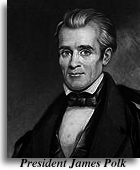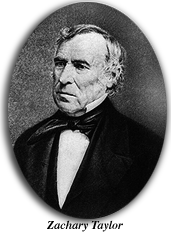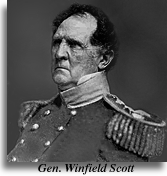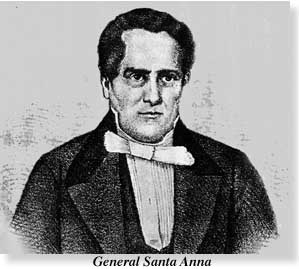
Full
text of the Treaty
"Ranch
and Mission Days in Alta California," by Guadalupe Vallejo
"Life
in California Before the Gold Discovery," by John Bidwell
John
Fremont and the Bear Flag Revolt - 1846
William
T. Sherman and Early Calif. History - 1847
Discovery
of Gold in California, by Gen. John Sutter - 1848
William
T. Sherman and the Gold Rush - 1848
California
Gold Rush Chronology 1846 - 1849
California
Gold Rush Chronology 1850 - 1851
California
Gold Rush Chronology 1852 - 1854
California
Gold Rush Chronology 1855 - 1856
California
Gold Rush Chronology 1857 - 1861
California
Gold Rush Chronology 1862 - 1865
An
Eyewitness to the Gold Discovery
Military
Governor Mason's Report on the Discovery of Gold
A
Rush to the Gold Washings - From the California Star
The
Discovery - as Viewed in New York and London
Steamer
Day in the 1850s
Sam
Brannan Opens New Bank - 1857
|
David
Saville Muzzey's popular 1911 text "American History" explained the Mexican
War to school children of the early twentieth century, told why the United
States seized California in 1846, and how the U.S. ended the Texas-Mexico
border dispute. The Treaty of Guadalupe-Hidalgo, which officially ended
the war, was signed in 1848, just nine days after gold was discovered at
Sutter's Mill. Dr. Muzzey's text also gave great insight into contemporary
American thinking about "Manifest Destiny." This text, and its revised
editions, was still in classroom use as late as the 1940's.
The
Mexican War
by
David Saville Muzzey, Ph.D.
Barnard
College, Columbia University, New York
Mexico
refuses to recognize the Annexation of Texas.
The
annexation of Texas was a perfectly fair transaction. For nine years, since
the victory of San Jacinto in 1836, Texas had been an independent republic,
whose reconquest Mexico had not the slightest chance of effecting.  In
fact, at the very moment of annexation, the Mexican government, at the
suggestion of England, had agreed to recognize the independence of Texas,
on condition that the republic should not join itself to the United States.
We were not taking Mexican territory, then, in annexing Texas. The new
state had come into the Union claiming the Rio Grande as her southern and
western boundary. By the terms of annexation all boundary disputes with
Mexico were referred by Texas to the government of the United States. President
Polk sent John Slidell of Louisiana to Mexico in the autumn of 1845 to
adjust any differences over the Texan claims. But though Slidell labored
for months to get a hearing, two successive presidents of revolution-torn
Mexico refused to recognize him, and he was dismissed from the country
in August, 1846. In
fact, at the very moment of annexation, the Mexican government, at the
suggestion of England, had agreed to recognize the independence of Texas,
on condition that the republic should not join itself to the United States.
We were not taking Mexican territory, then, in annexing Texas. The new
state had come into the Union claiming the Rio Grande as her southern and
western boundary. By the terms of annexation all boundary disputes with
Mexico were referred by Texas to the government of the United States. President
Polk sent John Slidell of Louisiana to Mexico in the autumn of 1845 to
adjust any differences over the Texan claims. But though Slidell labored
for months to get a hearing, two successive presidents of revolution-torn
Mexico refused to recognize him, and he was dismissed from the country
in August, 1846.
Taylor
attacked on the Rio Grande.
The
massing of Mexican troops on the southern bank of the Rio Grande, coupled
with the refusal of the Mexican government to receive Slidell, led President
Polk to order General Zachary Taylor to move to the borders. Taylor marched
to the Rio Grande and fortified a position on the northern bank. The Mexican
and the American troops were thus facing each other across the river. When
Taylor refused to retreat to the Nueces, the Mexican commander crossed
the Rio Grande, ambushed a scouting force of 63 Americans, and killed or
wounded 16 of them (April 24, 1846).
The
United States accepts War with Mexico.
When
the news of the attack reached Washington early in May, Polk sent a special
message to Congress, concluding with these words:
"We
have tried every effort at reconciliation...But now, after reiterated menaces,
Mexico has passed the boundary of the United States [the Rio Grande], has
invaded our territory and shed American blood upon the American soil. She
has proclaimed that hostilities have commenced, and that the two nations
are at war. As war exists, and, notwithstanding all our efforts to avoid
it, exists by the act of Mexico herself, we are called upon by every consideration
of duty and patriotism to vindicate with decision the honor, the rights,
and the interests of our country."
The
House and Senate, by very large majorities (174 to 14, and 40 to 2), voted
50,000 men and $10,000,000 for the prosecution of the war.
Taylor
invades Mexico.
 Meanwhile,
General Taylor had driven the Mexicans back to the south bank of the Rio
Grande in the battles of Palo Alto and Resaca de la Palma. Six days after
the vote of Congress sanctioning the war, he crossed the Rio Grande and
occupied the Mexican frontier town of Matamoros, whence he proceeded during
the summer and autumn of 1846 to capture the capitals of three of the Mexican
provinces. Meanwhile,
General Taylor had driven the Mexicans back to the south bank of the Rio
Grande in the battles of Palo Alto and Resaca de la Palma. Six days after
the vote of Congress sanctioning the war, he crossed the Rio Grande and
occupied the Mexican frontier town of Matamoros, whence he proceeded during
the summer and autumn of 1846 to capture the capitals of three of the Mexican
provinces.
The
Occupation of California and New Mexico.
As
soon as hostilities began, Commodore Sloat, in command of our squadron
in the Pacific, was ordered to seize California, and General [Stephen Watts]
Kearny was sent to invade New Mexico. The occupation of California was
practically undisputed. Mexico had only the faintest shadow of authority
in the province, and the 6000 white inhabitants made no objection to seeing
the flag of the United States raised over their forts. Kearny started with
1800 men from Fort Leavenworth, Kansas, in June, and on the eighteenth
of August defeated the force of 4000 Mexicans and Indians which disputed
his occupation of Santa Fé. After garrisoning this important post
he detached Colonel Doliphan with 850 men to march through the northern
provinces of Mexico and effect a juncture with General Taylor at Monterey,
while he himself with only 100 men continued his long journey of 1500 miles
to San Diego, California, where he joined Sloat's successor, Stockton.
Taylor's
Victory at Buena Vista.
After
these decided victories and uninterrupted marches of Taylor, Kearny, Sloat,
Stockton, and Doniphan, the Mexican government was offered a fair chance
to treat for peace, which it refused. Then President Polk decided, with
the unanimous consent of his cabinet, to strike at the heart of Mexico.  General
Winfield Scott, a hero of the War of 1812, was put in command of an army
of about 12,000 men, to land at Vera Cruz and fight his way up the mountains
to the capital city of Mexico. Santa
Anna, who, by the rapid shift of revolutions, was again dictator in
Mexico, heard of this plan to attack the capital and hastened north with
20,000 troops to surprise and destroy Taylor's army before Scott should
have time to take Vera Cruz. But Taylor, with an army one-fourth the size
of Santa Anna's, drove the Mexicans back in the hotly contested battle
of Buena Vista (February 23, 1847), securing the Californian and New Mexican
conquests. Santa Anna hastened southward to the defense of the city of
Mexico. General
Winfield Scott, a hero of the War of 1812, was put in command of an army
of about 12,000 men, to land at Vera Cruz and fight his way up the mountains
to the capital city of Mexico. Santa
Anna, who, by the rapid shift of revolutions, was again dictator in
Mexico, heard of this plan to attack the capital and hastened north with
20,000 troops to surprise and destroy Taylor's army before Scott should
have time to take Vera Cruz. But Taylor, with an army one-fourth the size
of Santa Anna's, drove the Mexicans back in the hotly contested battle
of Buena Vista (February 23, 1847), securing the Californian and New Mexican
conquests. Santa Anna hastened southward to the defense of the city of
Mexico.
Scott
take the city of Mexico.
Scott
took Vera Cruz in March and worked his way slowly but surely, against forces
always superior to his own, up to the very gates of Mexico (August, 1847).
Here he paused, by the President's orders, to allow the Mexicans another
chance to accept the terms of peace which the United States offered,-the
cession by Mexico of New Mexico and California in return for a large payment
of money. The Mexican commissioners, however, insisted on having both banks
of the Rio Grande and all of California up to the neighborhood of San Francisco,
besides receiving damages for injuries inflicted by the American troops
in their invasions. These claims were preposterous, coming from a conquered
country, and there was nothing left for Scott to do but to resume military
operations. Santa Anna defended the capital with a force of 30,000 men,
but the Mexicans were no match for the American soldiers. Scott stormed
the fortified hill of Chapultepec and advanced to the gates of the city.
On the thirteenth of September his troops entered the Mexican capital and
raised the Stars and Strips over "the palace of the Montezumas."
Polk's
Efforts to secure Peace.
 From
the beginning of the war Polk had been negotiating for peace. He had kept
Slidell in Mexico long after the opening of hostilities and had sent Nicholas
Trist as special peace commissioner to join Scott's army at Vera Cruz and
to offer Mexico terms of peace at the earliest possible moment. He had
allowed Santa Anna to return to Mexico from his exile in Cuba in the summer
of 1846, because the wily and treacherous dictator held out false promises
of effecting a reconciliation between Mexico and the United States. He
had asked Congress for an appropriation of $2,000,000 for peace negotiations
when General Taylor was still near the Rio Grande, ten days before General
Kearny had taken Santa Fé and the province of New Mexico, and before
General Scott's campaign had been thought of. From
the beginning of the war Polk had been negotiating for peace. He had kept
Slidell in Mexico long after the opening of hostilities and had sent Nicholas
Trist as special peace commissioner to join Scott's army at Vera Cruz and
to offer Mexico terms of peace at the earliest possible moment. He had
allowed Santa Anna to return to Mexico from his exile in Cuba in the summer
of 1846, because the wily and treacherous dictator held out false promises
of effecting a reconciliation between Mexico and the United States. He
had asked Congress for an appropriation of $2,000,000 for peace negotiations
when General Taylor was still near the Rio Grande, ten days before General
Kearny had taken Santa Fé and the province of New Mexico, and before
General Scott's campaign had been thought of.
The
Treaty of Guadalupe-Hidalgo.
When
the Mexican commissioners made advances for peace at the beginning of the
year 1848, they were given terms almost as liberal as those offered them
before Scott had stormed and occupied their capital. By the treaty concluded
at Guadalupe-Hidalgo, February 2, 1848, Mexico was required to cede California
and New Mexico to the United States and to recognize the Rio Grande as
the southern and western boundary of Texas. In return, the United States
paid Mexico $15,000,000 cash and assumed some $3,250,000 more in claims
of American citizens on the Mexican government. Considering the facts that
California was scarcely under Mexican control at all and might have been
taken at any moment by Great Britain, France, or Russia; that New Mexico
was still the almost undisturbed home of Indian tribes; that the land from
the Nueces to the Rio Grande was almost a desert; and that the American
troops were in possession of the Mexican capital, the terms offered Mexico
were very generous. Polk was urged by many to annex the whole country of
Mexico to the United States, but he refused to consider such a proposal.
The
Justice of the Mexican War.
The
Mexican War has generally been condemned by American historians as "the
foulest blot on our national honor," a war forced upon Mexico by slaveholders
greedy for new territory, a perfect illustration of La Fontaine's fable
of the wolf picking a quarrel with the lamb solely for an excuse to devour
him. But Mexico had insulted our flag, plundered our commerce, imprisoned
our citizens, lied to our representatives, and spurned our envoys. As early
as 1837 President Jackson said that Mexico's offenses "would justify in
the eyes of all nations immediate war." To be sure we were a strong nation
and Mexico a weak one. But weakness should not give immunity to continued
and open insolence. We had a right to annex Texas after that republic had
maintained its independence for nine years; yet Mexico made annexation
a cause of war. We were willing to discuss the boundaries of Texas with
Mexico; but our accredited envoy was rejected by two successive Mexican
presidents, who were afraid to oppose the war spirit of their country.
We even refrained from taking Texas into the Union until Great Britain
had interfered so far as to persuade Mexico to recognize the independence
of Texas if she would refuse to join the United States.
The
Moral Aspect of the Annexation of Texas.
If
there was anything disgraceful in the expansionist program of the decade
1840-1850, it was not the Mexican War, but the annexation of Texas. The
position of the abolitionists on this question was clear and logical. They
condemned the annexation of Texas as a wicked extension of the slavery
area, notwithstanding all arguments about "fulfilling our manifest destiny"
or "attaining our natural boundaries." To annex Texas might be legally
right, they said, but it was morally wrong. James Russell Lowell, in his
magnificent poem "The Present Crisis" (1844), warned the annexationists
that "They enslave their children's children who make compromise with sin."
We certainly assumed a great moral responsibility when we annexed Texas.
However, it was not to Mexico that we were answerable, but to the enlightened
conscience of the nation.
Completion
of the Program of Expansion.
With
our acquisition of the Oregon territory to the forty-ninth parallel by
the treaty of 1846 with Great Britain, and the cession of California and
New Mexico by the treaty of Guadalupe-Hidalgo in 1848, the boundaries of
the United States reached practically their present limits. The work of
westward extension was done. Expansion, the watchword of the decade 1840-1850,
was dropped from our vocabulary for fifty years, and the immense energies
of the nation were directed toward finding a plan on which the new territory
could be organized in harmony with the conflicting interests of the free
and slave sections of our country.
IN: An American History, by David Saville Muzzey.
Boston
: Ginn Company, 1911
Return
to the top of the page.
|